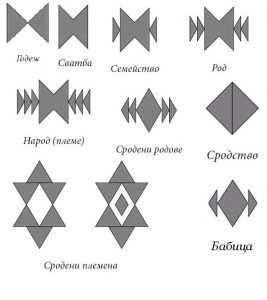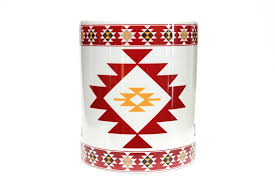From "Once upon a time - manners and worldview of the Bulgarians"
Here are some of the most common symbols woven into clothing and rugs
SCISSORS - ENGAGEMENT
Маказът е основен знак при символите за семейство и род. Маказ на български означава разклонение, знак за мъжкото и женското начало, за божественото и земното. Маказът интерперетира двете части на Ромба на тялото на костенурката – символ на планетата, разделен на два триъгълника. Допирането на върховете на двата триъгълника е началото, първия контакт, тоест годеж в половата символика. Когато двата триъгълника са допрени със широката си страна, символът означава Сродство, Сродяване.
BIG SCISSORS - WEDDING
When the two triangles connected again at the points, but penetrated into each other, symbolize the realization of a betrothal, the sexual sacrament is already known. This sign symbolizes the Wedding and subsequent conception. This is a symbol of Marriage, of the Father and Mother in their sexual sacred unity, of the future parents.
Folklore collection "Once upon a time - manners and worldview of the Bulgarians"
FAMILY OR KANATICA
Here two smaller triangles are added to the large scissor, with the tips touching on each side. These are the Mother and the Father who have fulfilled their primary purpose – to give birth to generations and continue the family. Everything that was set as a symbol in Makaza was realized in the Great Makaza and is already a reality - children were born. The triangles illustrate exactly two children. The two small triangles are not exactly gendered. The symbol is universal and can be interpreted in various possible variants: a boy and a girl, two boys or two girls. Each is next to one of its parents and accepts its symbolism - male or female.
A LARGE ROW OR ROD
When in the family birth has taken place repeatedly, which is also the main goal, it is the turn of the next symbol, which shows the growth of the family and the genus. Two more triangles are added to the sides, which means that we already have several generations. This symbol shows that the family is fertile and has no problem growing and becoming a large family.
see also: Embroidery and symbols in costumes
GREAT KANATICA OR PEOPLE
It is the symbol of the people, many families and genera, genetically related to each other in a common being. The fertility symbol is now tripled. It shows the presence of an entire ethnic group, related by blood. This tribe, this nation is made up of clans and clans. The young representatives of these genera naturally learn about the sacrament of sex, but here the symbol is not directed to the two separate souls, man and woman, but to the two genera that are related. The triangles are touched with their wide sides, which symbolizes the unity of the two families, in which the members are not related by sex, but through one of the relatives of the newlyweds, we also call them Swats - the members of the Wedding, the relatives up to the last knee in the line of the kinship. That is why this sign is the basis for the next figure, a symbol of the kinship of the genera.
GRANDMA
(related families – with two outward pointing triangles)
Here we have an interpretation of Kanatitsa, but the triangles symbolizing the generations point outward, not inward, i.e. back to Kanatitsa. In this symbol, they are not the designation of children in the family, but of the members of the genus who have sexually matured and have related to other genera, created families. This is a symbol of inter-gender fusion of Bulgarians' DNA.
In the Babitza symbol we see an interpretation of the Kanatitsa sign, but with triangles illustrating birth, the generations pointing outwards from the body of the main symbol. They are reversed to those in the cord. Now the triangles illustrate not the children of the family, but the members of the genus who have effected consanguinity, created families with members of another genus. We have a symbol of intergenerational sexual fusion of the DNA of the Bulgarians. Outward pointing indicates that someone is leaving the lineage to join another lineage.
GREAT GRANDMOTHER OR RELATED GENERA - Grandmother - with two triangles pointing outwards - there are already many who have left the family and have become related to another family, as well as many who have joined this family.
RELATED TRIBES
This symbol is much more significant and carries a multi-layered meaning. The rhombus in the middle symbolizes the sexual sacrament of Kinship, we already have kindred tribes. The vertical rhombuses above and below are a symbol of the man and woman of two tribes who gave life. Both triangles symbolize that children are born and these children belong to two genera but one people. We see how sacredly these ideas are expressed in the two triangles – they lie equally on the two scissors, symbolizing the two couples of the different genders. And again the established gender options of this birth – boy or girl. And again we see the brilliant symbolism - not reflecting the sexes, but the possibility of their birth.
 In addition to a wishful character, the symbols of the embroideries also had a denotative character. They were a clear indicator of people's social status. Maids and bachelors may not wear the clothes of those who are already married, and it is not proper for brides to dress as maidens.
In addition to a wishful character, the symbols of the embroideries also had a denotative character. They were a clear indicator of people's social status. Maids and bachelors may not wear the clothes of those who are already married, and it is not proper for brides to dress as maidens.
When the bride gave gifts to the wedding party's families and relatives, her gifts were strictly symbolic, according to her attitude towards the relatives. To the bridegroom's unmarried sister, the bride will give an apron with predominant symbols of Makaz or giliam Makaz, with which she wishes for an early engagement and wedding, to become a bride like her. If the groom has a married sister who has already given birth to children, the symbols in the gifts will be Kanatitsa or Big Kanatitsa and will carry a wish for the family to grow into a large family, for fertility and immortality of the family. If the sister is engaged or married, but has no children yet, the symbols in her gifts will carry the message of Big Scissors and Kanatitsa.
The symbols of Velik Kanatitsa or Velika Babitsa are also suitable for high-ranking guests - boyars, bagains. These symbols reflect their position in society, they show that they are progenitors, their role is that of Mother and Father, and their wish is for their families to survive.
© 2023 Iliana Dechkova

